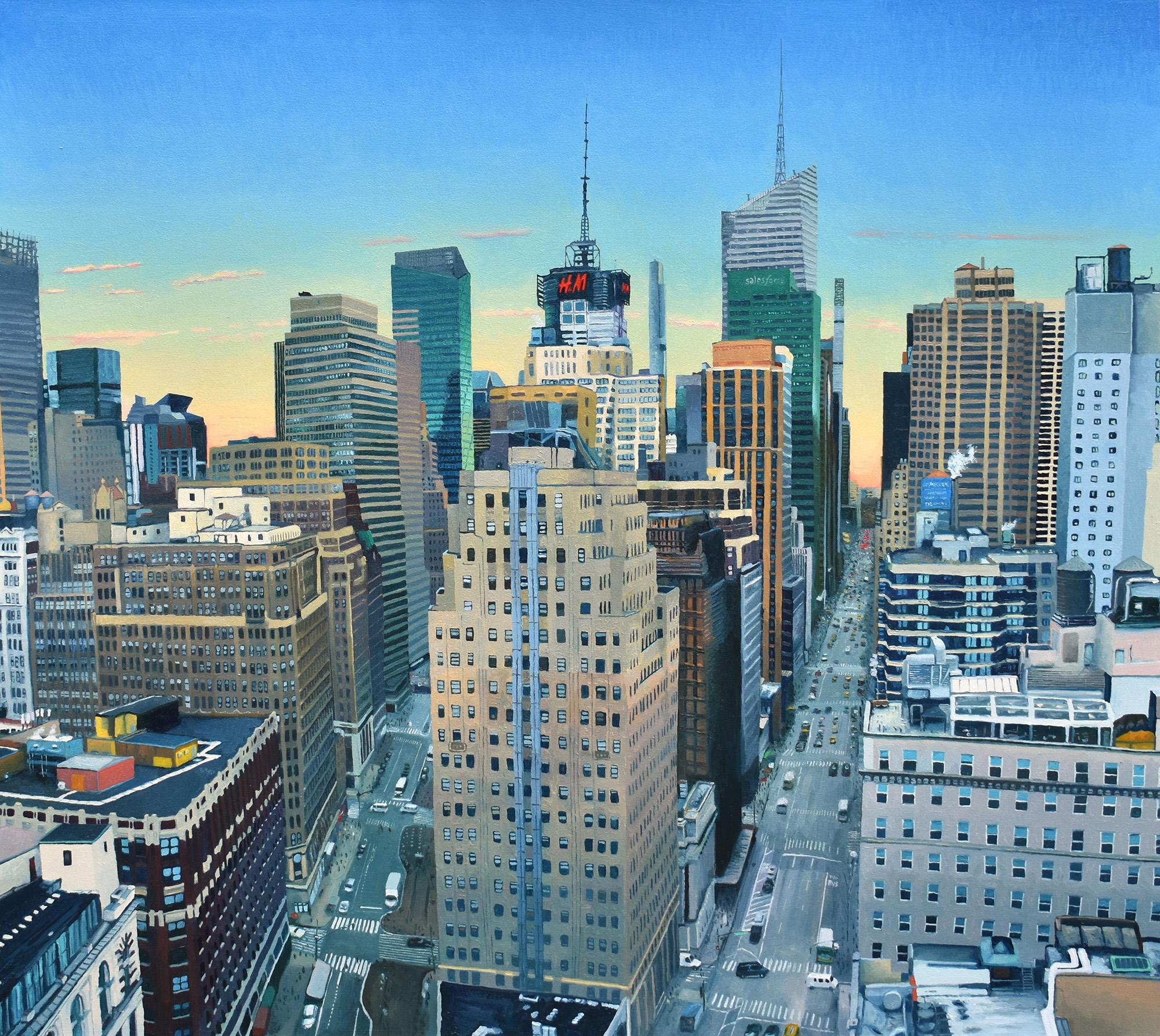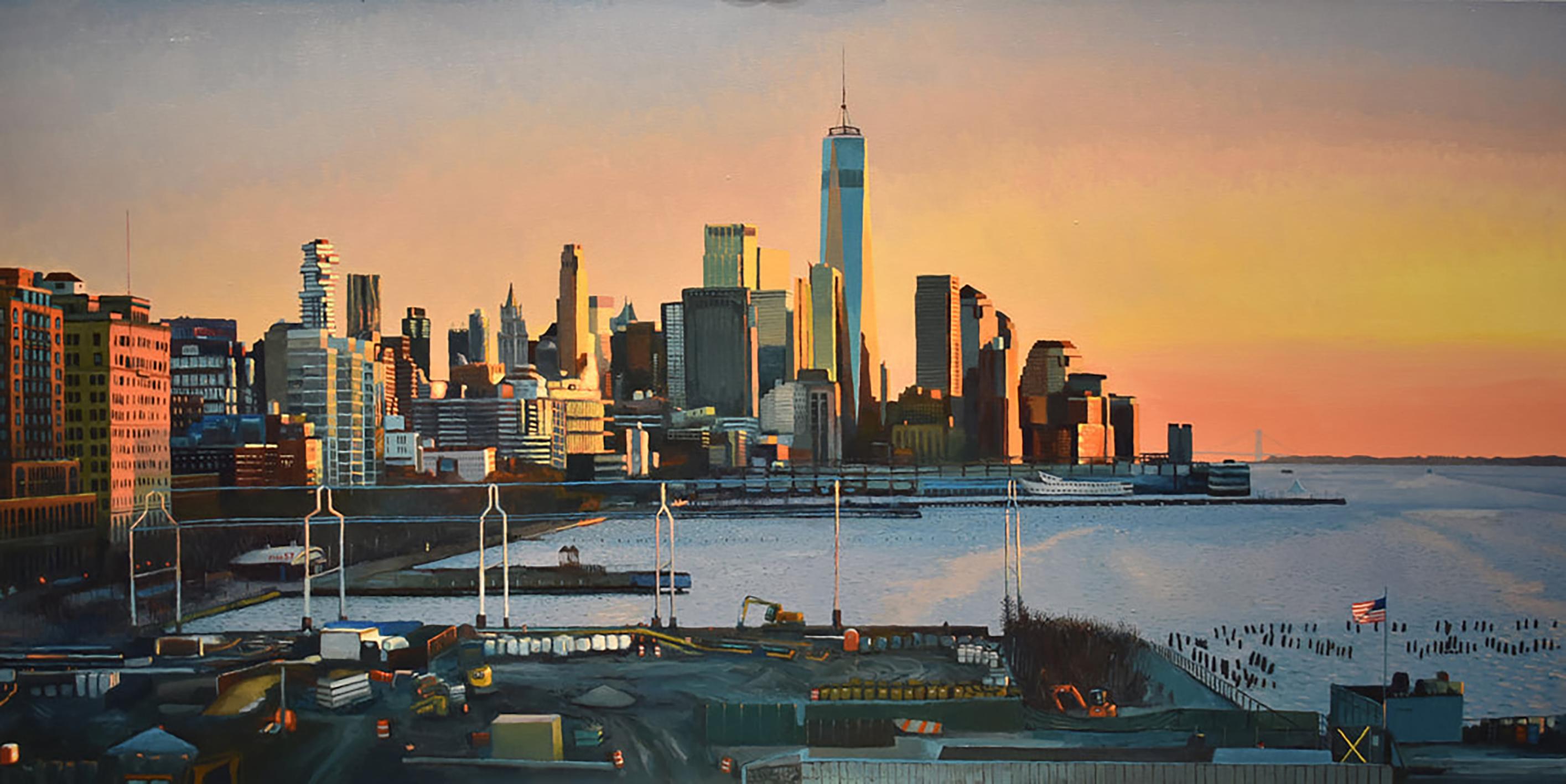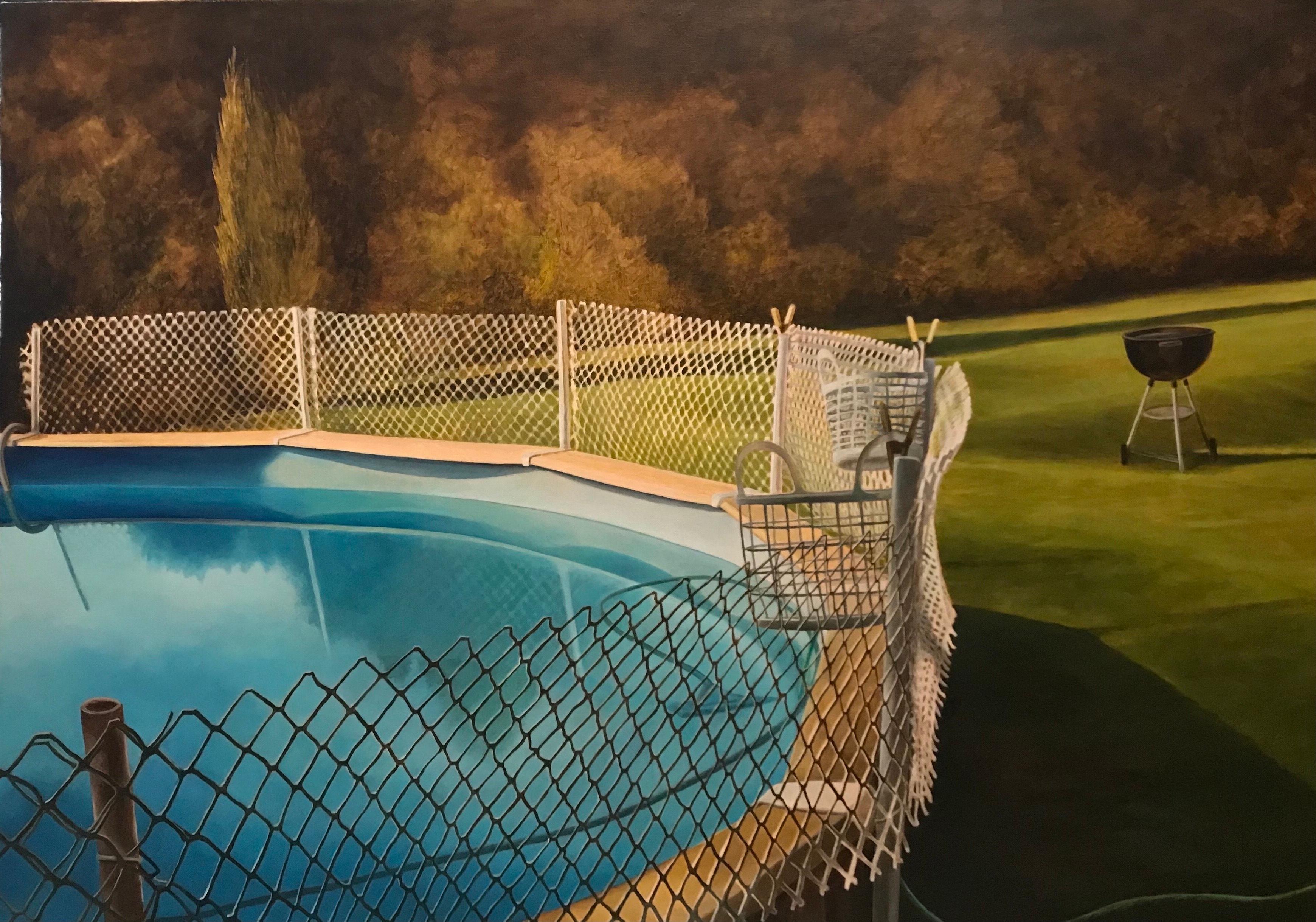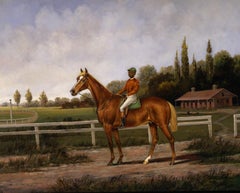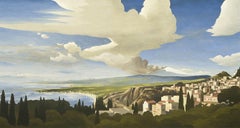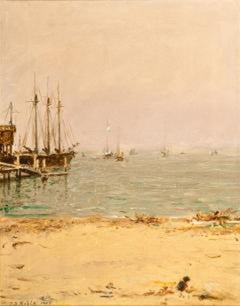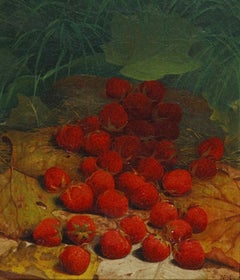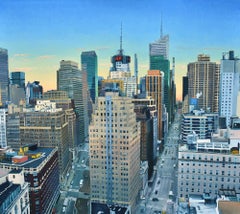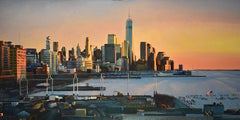Items Similar to Fishing Camp on the Labrador Coast
Want more images or videos?
Request additional images or videos from the seller
1 of 7
William BradfordFishing Camp on the Labrador CoastN.d.
N.d.
About the Item
In 1852, twenty-nine year old William Bradford was a failing shopkeeper in Fairhaven, Massachusetts. With a wife and child at home, Bradford, by his own admission, “spent too much time in painting to succeed” in business. Rescued from insolvency by his well-to-do in-laws, this is not the beginning of a narrative that generally leads to a happy ending. Not so with Bradford, who ultimately found international fame and fortune as a painter of arctic seascapes and dramatic marine paintings.
William Bradford, the artist, was a lineal descendant of the 17th-century Separatist leader William Bradford, a founder of the Plymouth Plantation, signer of the Mayflower Compact and Governor of the Plymouth Colony. Our Bradford born to a New Bedford ship outfitter in Fairhaven, Massachusetts By the nineteenth century, this line of Bradfords were Quakers, living on the tract purchased nearly two centuries earlier by their pilgrim ancestor. Fairhaven, across the mouth of the Acushnet River from the whaling center of New Bedford was described by a New York journalist in 1857 as “the Brooklyn of New Bedford” (Home Journal, January 3, 1857). Young Bradford displayed an early predilection for the arts, but his Quaker parents were disinclined to support this particular pursuit. After working in his father’s business and then for a dry goods merchant in New Bedford, by 1849 Bradford had set up in New Bedford as a “merchant tailor” offering outfits for “those going to California,” “seamen’s clothing,” custom-tailored “piece goods” and “friend’s wear." But despite his parents’ best efforts, Bradford was an indifferent businessman, finding his passion on the shores of the New Bedford harbor, accompanied by sketch book and easel. By 1852, Bradford had determined to pursue a career as a marine painter.
Bradford would have studied books on naval architecture, marine drafting, as well as drawing instruction manuals, but more important, he closely observed the boats that crowded the wharves and waters around New Bedford. Bradford would also have benefitted by his exposure to the work of two famous marine artists working nearby, Robert Salmon and Gloucester native Fitz Henry Lane. By 1852, Bradford realized the limitations of his self-study He traveled to New York City and sought out Albert Van Beest (1820–1860), at the time the leading European marine painter in America, whom he convinced to come to Fairhaven and share a studio for two years. The two worked closely during their stay together, on several occasions collaborating on paintings. Bradford temporarily adopted Van Beest’s dramatic and expressive style, but, following their separation, he reverted to his characteristically realistic, linear approach to marine painting. Throughout his career, Bradford maintained a use of glowing light in his work that both enlivens and gives a sense of drama to his paintings, allying him with the overall painting movement now described as luminism.
While Bradford’s early practice consisted largely of ship portraits commissioned by Massachusetts ship owners, his time with Van Breest in the mid–1850s gave him new confidence and increased skill. In 1858, he contributed New Bedford Harbor at Sunset (New Bedford Whaling Museum) to the New Bedford Art Exhibition organized by his fellow townsman, Albert Bierstadt. Afterward, he accompanied Bierstadt on a sketching expedition to Newport. In 1859, Bradford left behind his provincial beginnings. Moving to Boston, he took a space in the Tremont Street Studio Building. That same year he shared an exhibition at the Williams and Everett Gallery with Gloucester native Fitz Henry Lane (1804–1865). In 1860, Bradford exhibited for the first time at the National Academy of Design in New York and took a studio in the New York Tenth Street Studio Building, which he maintained as his winter headquarters with a few interruptions until 1877.
Bradford was among the first painters to employ extensively the use of photography in his work. On his several trips to the Arctic he documented his travels by taking numerous photographs. For the most celebrated of his expeditions, a trip in 1869 to the Arctic regions, Bradford left in a ship equipped with a full photographic studio. Upon his return, he drew inspiration from the many photographs he had taken, although he seems never to have copied any of his photographs directly into paintings. He instead used photography to familiarize himself with particular details of Arctic scenery, which he then translated to his canvases.
Following his arctic voyage of 1869, Bradford spent 1872 and 1873 in England. As had many of his marine-painter forebears, Bradford found favor with the English court. He was received by Queen Victoria and exhibited some of the approximately 700 photographs taken during the expedition. The Queen was apparently impressed, for she gave Bradford the most significant commission of his career. He painted The Panther off the Coast of Greenland under the Midnight Sun (coll. H.R.H. Queen Elizabeth II, London), which the Queen subsequently installed in her library at Windsor Castle. Following the successful reception of his photographs at court, Bradford determined to publish them along with a recounting of the voyage in a single volume. In 1873, he released The Arctic Regions, a huge volume which contained 125 hand-tipped photographs. Queen Victoria was its first subscriber. Contemporary reviews of The Arctic Regions were extremely favorable, which helped establish Bradford’s reputation as a painter. Bradford’s English audience, conditioned by the “truth to nature” art aesthetic of the influential critic, John Ruskin, appreciated the verisimilitude of his work. His paintings were seen as “the only works which profess incontrovertible truth in the representation of the northern regions” (“The Arctic Regions,” The Art Journal (London) XII [1873]).
By the late 1870s, Bradford was enormously successful. He moved west to California and established a studio in San Francisco. He painted such familiar West Coast landscapes as Mount Hood and Yosemite, much the same as his friend Albert Bierstadt, with whom Bradford earlier had shared space in New York’s Tenth Street Studio. In the late 1880s he returned east, where he continued to paint until his death in 1892.
- Creator:William Bradford (1823-1892, American)
- Creation Year:N.d.
- Dimensions:Height: 13.25 in (33.66 cm)Width: 20.5 in (52.07 cm)
- Medium:
- Movement & Style:
- Period:
- Condition:
- Gallery Location:New York, NY
- Reference Number:Seller: APG 20199D1stDibs: LU2310062422
About the Seller
5.0
Recognized Seller
These prestigious sellers are industry leaders and represent the highest echelon for item quality and design.
Established in 1952
1stDibs seller since 2010
34 sales on 1stDibs
Typical response time: 12 hours
Associations
Art Dealers Association of America
- ShippingRetrieving quote...Shipping from: New York, NY
- Return Policy
Authenticity Guarantee
In the unlikely event there’s an issue with an item’s authenticity, contact us within 1 year for a full refund. DetailsMoney-Back Guarantee
If your item is not as described, is damaged in transit, or does not arrive, contact us within 7 days for a full refund. Details24-Hour Cancellation
You have a 24-hour grace period in which to reconsider your purchase, with no questions asked.Vetted Professional Sellers
Our world-class sellers must adhere to strict standards for service and quality, maintaining the integrity of our listings.Price-Match Guarantee
If you find that a seller listed the same item for a lower price elsewhere, we’ll match it.Trusted Global Delivery
Our best-in-class carrier network provides specialized shipping options worldwide, including custom delivery.More From This Seller
View AllChestnut Racehorse with a Jockey Up On a Training Strap
By Henry H. Cross
Located in New York, NY
It was Henry Cross's portraits of horses belonging to the prominent breeders and trainers of the second half of the nineteenth century that won the artist renown as an animal painter. Born and raised in upstate New York, Cross's proficiency in both drafting and caricature was revealed while he was still a student at the Binghamton Academy, New York. In 1852, when he was only fifteen years old, Cross joined a traveling circus that took him to Minneapolis, Minnesota, and to the first of many Indian encampments that he would draw upon for subject matter throughout his career. Biographers differ as to the year Cross left for Europe, however, he was in Paris from 1852 to 1853 or 1854, where he studied with Rosa Bonheur, a highly esteemed French painter of horses. Upon Cross's return to the United States he was commissioned to paint the studs of wealthy horsemen, including those of Commodore Cornelius Vanderbilt, Robert Bonner, the owner-publisher of The New York Ledger, and "Copper King" Marcus Daly, whose 18,000 acre stock farm was reputed to be the greatest and most valuable horse ranch in the world.
Although Cross received the highest pay of any equine artist of his day (up to $35,000. for one order, according to The Horse Review of April 10, 1918, p. 328), he frequently joined traveling circuses and painted the locales where they visited. He also painted portraits of notable contemporaries, such as President Abraham Lincoln, ex-president Ulysses S. Grant, King Edward VII of England, W. F. "Buffalo Bill...
Category
19th Century American Realist Animal Paintings
Materials
Canvas, Oil
Mt. Etna from Taormina
By Thomas Fransioli
Located in New York, NY
Thomas Fransioli, born in 1906 in Seattle, Washington, trained as an architect at the University of Pennsylvania. He worked as an architect before his service in World War II. Largel...
Category
20th Century American Realist Landscape Paintings
Materials
Canvas, Oil
View of Gravesend Bay
Located in New York, NY
Thomas Satterwhite Noble, who studied in France with Thomas Couture for three years, adapted his master’s genre style to American subjects. Born on his parents’ plantation in Kentucky in 1835, Noble was the son of a wealthy rope manufacturer. His early upbringing in Lexington, the center of that state’s slave trade in the antebellum South...
Category
Early 20th Century American Realist Landscape Paintings
Materials
Canvas, Oil
Strawberries Strewn on a Forest Floor
By William Mason Brown
Located in New York, NY
William Mason Brown was born in Troy, New York, where he studied for several years with local artists, including the leading portraitist there, Abel Buel Moore. In 1850, he moved to ...
Category
19th Century American Realist Landscape Paintings
Materials
Canvas, Oil
New York from Hoboken
By William Rickarby Miller
Located in New York, NY
Signed (at lower left): W.R. Miller/ 1851
Category
Mid-19th Century American Realist Landscape Paintings
Materials
Canvas, Oil
Saint-Malo, Brittany
By William Stanley Haseltine
Located in New York, NY
The career of William Stanley Haseltine spans the entire second half of the nineteenth century. During these years he witnessed the growth and decline of American landscape painting, the new concept of plein-air painting practiced by the Barbizon artists, and the revolutionary techniques of the French Impressionists, all of which had profound effects on the development of painting in the western world. Haseltine remained open to these new developments, selecting aspects of each and assimilating them into his work. What remained constant was his love of nature and his skill at rendering exactly what he saw. His views, at once precise and poetic, are, in effect, portraits of the many places he visited and the landscapes he loved.
Haseltine was born in Philadelphia, the son of a prosperous businessman. In 1850, at the age of fifteen, he began his art studies with Paul Weber, a German artist who had settled in Philadelphia two years earlier. From Weber, Haseltine learned about Romanticism and the meticulous draftsmanship that characterized the German School. At the same time, Haseltine enrolled at the University of Pennsylvania, and took sketching trips around the Pennsylvania countryside, exploring areas along the Delaware and Susquehanna rivers. Following his sophomore year, Haseltine transferred to Harvard University.
After graduating from Harvard in 1854, Haseltine returned to Philadelphia and resumed his studies with Weber. Although Weber encouraged Haseltine to continue his training in Europe, the elder Haseltine was reluctant to encourage his son to pursue a career as an artist. During the next year, Haseltine took various sketching trips along the Hudson River and produced a number of pictures, some of which were exhibited at the Pennsylvania Academy of the Fine Arts in the spring of 1855. Ultimately, having convinced his father that he should be allowed to study in Europe, Haseltine accompanied Weber to Düsseldorf.
The Düsseldorf Academy was, during the 1850s, at the peak of its popularity among American artists. The Academy’s strict course of study emphasized the importance of accurate draftsmanship and a strong sense of professionalism. Landscape painting was the dominant department at the Düsseldorf Academy during this period, and the most famous landscape painter there was Andreas Achenbach, under whom Haseltine studied. Achenbach’s realistic style stressed close observation of form and detail, and reinforced much of what Haseltine had already learned. His Düsseldorf training remained an important influence on him for the rest of his life.
At Düsseldorf, Haseltine became friendly with other American artists studying there, especially Emanuel Leutze, Worthington Whittredge, and Albert Bierstadt. They were constant companions, and in the spring and summer months took sketching trips together. In the summer of 1856 the group took a tour of the Rhine, Ahr, and Nahe valleys, continuing through the Swiss alps and over the Saint Gotthard Pass into northern Italy. The following summer Haseltine, Whittredge, and the painter John Irving returned to Switzerland and Italy, and this time continued on to Rome.
Rome was a fertile ground for artists at mid-century. When Haseltine arrived in the fall of 1857, the American sculptors Harriet Hosmer, Chauncey B. Ives, Joseph Mozier, William Henry Rinehart...
Category
19th Century American Realist Landscape Paintings
Materials
Canvas, Oil
You May Also Like
Street of the Old Quarter British School signed Cade oil on canvas painting
Located in Barcelona, Barcelona
**Technical Sheet**
**Title:** "Street of the Old Quarter"
**Author:** British School, 19th Century
**Date:** 1892
**Technique:** Oil on canvas
**Dimensions:** 14.17 x 10.63 inc...
Category
1890s American Realist Figurative Paintings
Materials
Oil, Canvas
$926 Sale Price
33% Off
Morning Coffee
By David Leonard
Located in Fairfield, CT
The primary subjects of my paintings are 21st century man's working monuments, which represent our culture's dedication to production and consumption. The essence of our way of life ...
Category
21st Century and Contemporary American Realist Landscape Paintings
Materials
Canvas, Oil
Among Piers
By David Leonard
Located in Fairfield, CT
The primary subjects of my paintings are 21st century man's working monuments, which represent our culture's dedication to production and consumption. The essence of our way of life ...
Category
21st Century and Contemporary American Realist Landscape Paintings
Materials
Canvas, Oil
Useless (painting vintage old car wreck nostalgia light blue auto oil painting)
By Rudolf Kosow
Located in Quebec, Quebec
keywords; surrealism, portrait, oil painting, representation painting, strangeness, contemporary surrealistic, unsettling, contemporary realist painting, dreams, symbolic composition, tonalist, grey, monochrome, nostalgic, vintage, early century, illustration, car, automobile, tractor, old car wreck...
Category
2010s American Realist Landscape Paintings
Materials
Canvas, Oil
"Playground, Carl Schurz Park" George Picken, New York City, East River, UES WPA
By George Picken
Located in New York, NY
George Picken
Playground, Carl Schurz Park, 1938
Signed and dated lower left
Oil on canvas
28 x 36 inches
Provenance:
Estate of the artist
A native New Yorker, George Picken was born in 1898. His father, an artist and photographer, emigrated from Scotland; his mother came from Wales. They joined other European immigrants settling in New York City’s Hell’s Kitchen. Picken enlisted in the army during World War I and saw action at Verdun. After the war, he stayed in France and like many Americans returning from the vibrant Paris art scene, was inspired by the radical movement known as Impressionism. Upon his return Picken decided to follow in his father’s footsteps and become an artist.
George began his studies in 1919 at the Art Students League during Robert Henri, Max Weber, and John Sloan’s tenure. There he took classes in studio art, illustration, and etching through 1923 studying extensively with George Bridgman. The writings of French philosopher Henri Bergson were widely circulated among the artistic community and looking at Picken’s early paintings one cannot help but wonder if as a young artist he was influenced by Bergson’s ideas. Bergson said, "[There are] two profoundly different ways of knowing a thing. The first implies that we move round the object; the second that we enter into it. The first depends on the point of view at which we are placed and on the symbols by which we express ourselves. The second neither depends on a point of view nor relies on any symbol. The first kind of knowledge may be said to stop at the relative; the second, in those cases where it is possible, to attain the absolute.”
Picken’s recognition came early with showings of his work while he was a student. His drawings were published in the New Masses, a significant left-wing publication. The New York Public Library honored him with one-man shows in 1924 and 1928 and his work was included in group exhibitions at the Louis Comfort Tiffany Foundation, the Whitney Studio Club, Montross Gallery, and the Art Students League. During this time Picken married Viola Carton, one of Reginald Marsh’s models, and they lived in Westchester. Later they moved to Yorkville in Manhattan between 82nd street and East End Avenue where they began their family. Picken’s grandson Niles Jaeger recalled that, “Grandpa’s home and studio were in a five-story walk-up apartment, heated only by a coal stove. But there were wonderful views of the East River and the Queensborough Bridge...
Category
1930s American Realist Landscape Paintings
Materials
Canvas, Oil
$22,400 Sale Price
20% Off
"Pool Fence Letter of the Law" Contemporary Oil Painting
Located in New York, NY
This compelling fine art painting presents a rural above-ground pool, enclosed by a makeshift chain-link fence, set against a sunlit landscape of rolling green grass and dense tree l...
Category
2010s American Realist Still-life Paintings
Materials
Canvas, Oil
Recently Viewed
View AllMore Ways To Browse
The Tailor Art
N Toor
California San Francisco Coast Painting
William Ship Painting
New Bedford
Queen Victoria Art
William Winter
William Castle
English Coast
19th Century Painting Fishing
Nineteenth 19th Century Landscape
Yosemite Painting
Antique Native American Painting
Fishing Portraits
Books On Boats
Victoria N
New England Marine Landscapes
English Fishing Art
